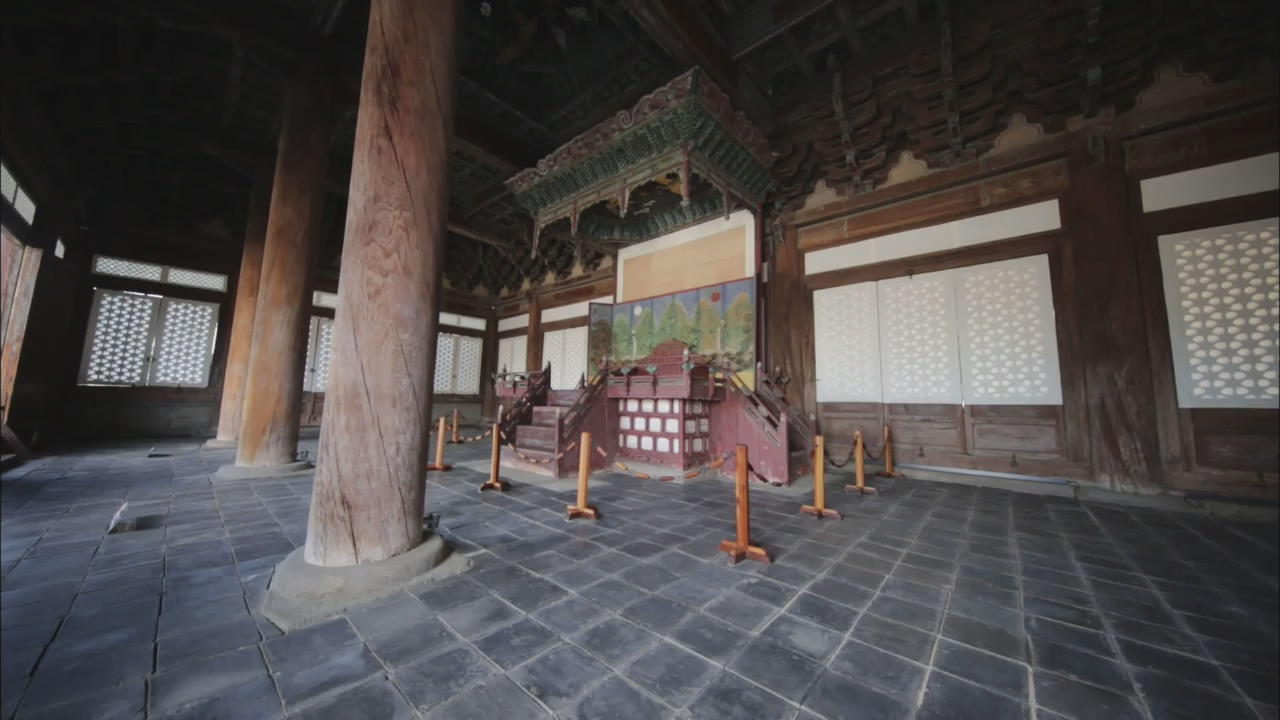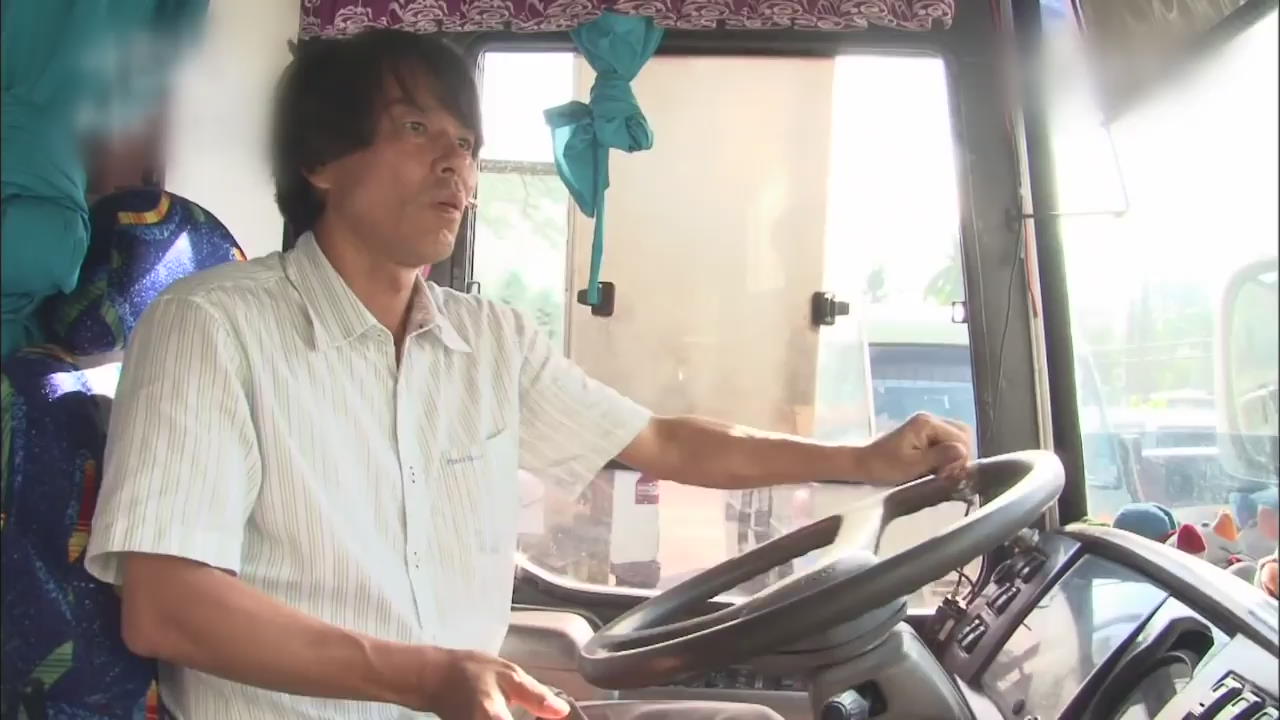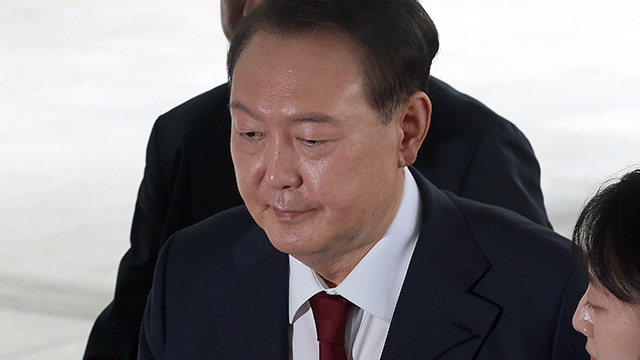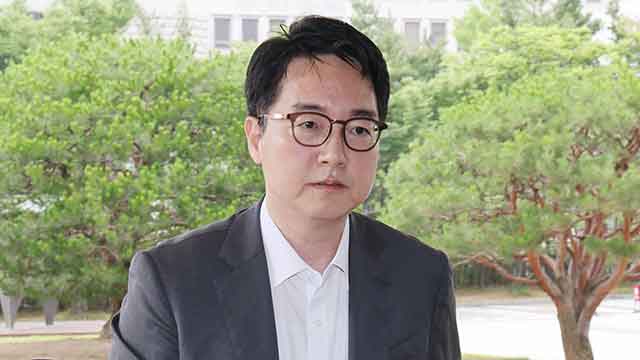Myeongjeongjeon Hall
입력 2019.04.04 (15:24)
수정 2019.04.04 (15:36)
읽어주기 기능은 크롬기반의
브라우저에서만 사용하실 수 있습니다.
[Anchor Lead]
Myeongjeongjeon Hall in Changgyeonggung Palace is the oldest structure among the royal palaces of the Joseon Dynasty. The inside of the hall has been recently disclosed to the public for the first time since its construction four centuries ago. Take a look.
[Pkg]
Changgyeonggung is the third royal palace of the Joseon Dynasty. The moment you enter its front gate, the main hall of the palace, Myeongjeongjeon, reveals its dignified appearance. The hall was burned during Japanese invasions of Joseon in the 16th century, but it was re-built in 1616. The enthronement ceremony for Joseon's 12th monarch, King Injong, was also held at Myeongjeongjeon. Recently, the hall was opened to the public for the first time in four centuries. Its ceiling is decorated with a pair of golden phoenixes symbolizing the king's power. There are also golden phoenixes above the king's throne surrounded by a folding screen depicting natural scenery. However, everything else in the structure looks quite simple.
[Soundbite] Prof. Kwak Dong-hae(Hanseo University) : "Historic documents say that paint was urgently brought from China to decorate the hall. It shows how difficult the situation was at the time."
After the destructive fire at Sungnyemun Gate, Myeongjeongjeon Hall became the only structure featuring the architecture of the early and mid-Joseon period that has been preserved intact. From now on, tourists will be able to see the inside of the priceless cultural property every spring and fall.
Myeongjeongjeon Hall in Changgyeonggung Palace is the oldest structure among the royal palaces of the Joseon Dynasty. The inside of the hall has been recently disclosed to the public for the first time since its construction four centuries ago. Take a look.
[Pkg]
Changgyeonggung is the third royal palace of the Joseon Dynasty. The moment you enter its front gate, the main hall of the palace, Myeongjeongjeon, reveals its dignified appearance. The hall was burned during Japanese invasions of Joseon in the 16th century, but it was re-built in 1616. The enthronement ceremony for Joseon's 12th monarch, King Injong, was also held at Myeongjeongjeon. Recently, the hall was opened to the public for the first time in four centuries. Its ceiling is decorated with a pair of golden phoenixes symbolizing the king's power. There are also golden phoenixes above the king's throne surrounded by a folding screen depicting natural scenery. However, everything else in the structure looks quite simple.
[Soundbite] Prof. Kwak Dong-hae(Hanseo University) : "Historic documents say that paint was urgently brought from China to decorate the hall. It shows how difficult the situation was at the time."
After the destructive fire at Sungnyemun Gate, Myeongjeongjeon Hall became the only structure featuring the architecture of the early and mid-Joseon period that has been preserved intact. From now on, tourists will be able to see the inside of the priceless cultural property every spring and fall.
■ 제보하기
▷ 카카오톡 : 'KBS제보' 검색, 채널 추가
▷ 전화 : 02-781-1234, 4444
▷ 이메일 : kbs1234@kbs.co.kr
▷ 유튜브, 네이버, 카카오에서도 KBS뉴스를 구독해주세요!
- Myeongjeongjeon Hall
-
- 입력 2019-04-04 15:26:13
- 수정2019-04-04 15:36:51

[Anchor Lead]
Myeongjeongjeon Hall in Changgyeonggung Palace is the oldest structure among the royal palaces of the Joseon Dynasty. The inside of the hall has been recently disclosed to the public for the first time since its construction four centuries ago. Take a look.
[Pkg]
Changgyeonggung is the third royal palace of the Joseon Dynasty. The moment you enter its front gate, the main hall of the palace, Myeongjeongjeon, reveals its dignified appearance. The hall was burned during Japanese invasions of Joseon in the 16th century, but it was re-built in 1616. The enthronement ceremony for Joseon's 12th monarch, King Injong, was also held at Myeongjeongjeon. Recently, the hall was opened to the public for the first time in four centuries. Its ceiling is decorated with a pair of golden phoenixes symbolizing the king's power. There are also golden phoenixes above the king's throne surrounded by a folding screen depicting natural scenery. However, everything else in the structure looks quite simple.
[Soundbite] Prof. Kwak Dong-hae(Hanseo University) : "Historic documents say that paint was urgently brought from China to decorate the hall. It shows how difficult the situation was at the time."
After the destructive fire at Sungnyemun Gate, Myeongjeongjeon Hall became the only structure featuring the architecture of the early and mid-Joseon period that has been preserved intact. From now on, tourists will be able to see the inside of the priceless cultural property every spring and fall.
Myeongjeongjeon Hall in Changgyeonggung Palace is the oldest structure among the royal palaces of the Joseon Dynasty. The inside of the hall has been recently disclosed to the public for the first time since its construction four centuries ago. Take a look.
[Pkg]
Changgyeonggung is the third royal palace of the Joseon Dynasty. The moment you enter its front gate, the main hall of the palace, Myeongjeongjeon, reveals its dignified appearance. The hall was burned during Japanese invasions of Joseon in the 16th century, but it was re-built in 1616. The enthronement ceremony for Joseon's 12th monarch, King Injong, was also held at Myeongjeongjeon. Recently, the hall was opened to the public for the first time in four centuries. Its ceiling is decorated with a pair of golden phoenixes symbolizing the king's power. There are also golden phoenixes above the king's throne surrounded by a folding screen depicting natural scenery. However, everything else in the structure looks quite simple.
[Soundbite] Prof. Kwak Dong-hae(Hanseo University) : "Historic documents say that paint was urgently brought from China to decorate the hall. It shows how difficult the situation was at the time."
After the destructive fire at Sungnyemun Gate, Myeongjeongjeon Hall became the only structure featuring the architecture of the early and mid-Joseon period that has been preserved intact. From now on, tourists will be able to see the inside of the priceless cultural property every spring and fall.
이 기사가 좋으셨다면
-
좋아요
0
-
응원해요
0
-
후속 원해요
0














![[영상] 정성호 “검찰 해체 표현 적절치 않아…수사·기소 분리 국민 공감대”](/data/fckeditor/vod/2025/07/01/305901751367182615.png)


이 기사에 대한 의견을 남겨주세요.